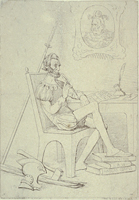Another fine Disunion piece, this one on the importance of the telegraph in disseminating war news to the nation. There is plenty of documentation of Lincoln’s time spent in the Telegraph Office, but I hadn’t realised the genesis nor the explanation for this habit. We have McClellan to thank for the many anecdotes relayed (ahem – little telegraph joke there) by the office’s staff. I’ve listed two more Library “holdings” below as examples.
Perhaps the most consequential adoption of the telegraph was in journalism. In the late 1840s, the establishment of the New York Associated Press made it possible for member newspapers to share the costs of the new technology in order to gather news. By the early 1850s, content from the A.P. comprised at least two columns of every major daily newspaper, and many readers considered this “telegraphic news” to be the most compelling and urgent part of the paper.
By 1860 the A.P. was distributing its news not just in New York but around the country, and this practice began to transform the very meaning of news. Local papers now had the capacity to report national events to their readers in a timely manner, so that “the news” gradually came to connote not just events, but events happening at almost that very moment. Prior to the telegraph, the distribution of news was regulated by the speed of the mail, but now news was potentially both instantaneous and simultaneous.
The immediacy of the news fed a public frenzy for the latest information. Circulation of New York papers rose by more than 40 percent during the war, and in other areas of the nation by as much as 63 percent. During a major battle, editors could expect to sell up to five times as many copies of their papers. While newspaper reporting remained highly competitive throughout the war, the A.P. came to dominate wire news, and this also served the interests of the Administration. The A.P. had regular access to the president and the War Department, and was given exclusive bulletins and announcements to disseminate to the papers. In exchange, the A.P. gave the administration a way to reach the public in a manner that could be carefully controlled and rapidly disseminated.
The Disunion article can be found here: http://opinionator.blogs.nytimes.com/2012/01/13/news-of-the-wired/?ref=opinion%2F%3Fsmid%3Dfb-disunion
The free books are:
Lincoln in the Telegraph Office, by David Homer Bates – http://www.archive.org/details/lincolnintelegr01bategoog. This one is promising! A quick search for “Tad” (there was a great anecdote about Tad Lincoln and a bottle of the Telegraph Office’s ink) reveals a fair number of hits, and there are some facsimiles of Lincoln’s handwritten messages in the HTML version.
A similar, yet much shorter, book is available here: http://www.archive.org/details/glimpseofuniteds00wils – William Bender Wilson’s A Glimpse of the United States Military Telegraph Corps. There are a few, less consequential, personal anecdotes about Lincoln. Still, any time with Lincoln is well spent.

